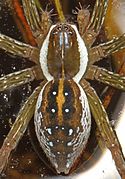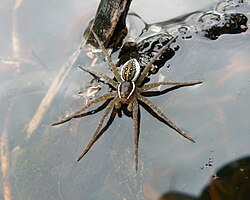American spiders and their spinningwork. A natural history of the orbweaving spiders of the United States, with special regard to their industry and habits (1890) (14591910267)
Leaf woven cocoon nest of Dolomedes sexpunctatus (now Dolomedes triton)
Identifier: americanspiderst02mcco (find matches)
Title: American spiders and their spinningwork. A natural history of the orbweaving spiders of the United States, with special regard to their industry and habits
Year: 1890 (1890s)
Authors: McCook, Henry C. (Henry Christopher), 1837-1911
Subjects: Spiders -- United States
Publisher: (Philadelphia) author, Academy of natural Sciences of Philadelphia
Contributing Library: MBLWHOI Library
Digitizing Sponsor: MBLWHOI Library
View Book Page: Book Viewer
About This Book: Catalog Entry
View All Images: All Images From Book
Click here to view book online to see this illustration in context in a browseable online version of this book.
Text Appearing Before Image:
wondered how the roundegg ball of the Lycosid was put together, and the mechanical ingenuity andsimplicity of the method were now apparent. Tlie period consumed inthe whole act of cocooning was less than four hours, and the act of ovi-positing took less than half an hour. Shortly after the egg sac was fin-ished the mother cut her way out of the silken cover woven over herlittle cavern. She had evidently thus secluded herself for the purpose ofspinning her cocoon. This was in accord with a firmty fixed habit of theLycosids to exclude themselves, before making their cocoons, in a burrowor cave which they form in the ground. This is often made under a stoneand is protected on the sides by a jjlastered wall of mud, and above againstthe stone by a piece of spinningwork which thus forms an upholsteredroof to this i>retty, cavernous home. An approach to the cave is cut, whichoften debouches among the grasses, clumps of clover, mosses, or wild How- GENERAL COCOONING HABITS OK SPIDERS. 145
Text Appearing After Image:
146 AMERICAN SPIDERS AND THEIR SPINNINGWORK. ers, that give a touch of natural heauty to the gateway. One of theseLycosid coeooiiing caves is shown at Figs. 175 and 176. It was made be-neath a stone, and when that was Ufted up the spider, Lycosa saccata,showed within as at Fig. 175. The roof of her den was broken off bylifting and is shown in inverted position at Fig. 176. The use of thisspecial cocooning den is common with Lycosids; but some species, andprobably all at times, live within the home burrow while carrying theircocoons. This is the habit of Lycosa arenicola, which may often be seenon her turret with her egg ball at her spinnerets. (See Vol. I., page 314,Fig. 2S9.) There is no flossy wadding within the cocoon case of Lycosids, as iscommon with Orbweaving spiders. Indeed, such a provision for the com-fort and safety of the brood appears wholly unnecessary in the case ofyounglings whose egg life is so brief, and of a mother who carries heryoung about with her, and thus gives
Note About Images
Relevante Bilder
Relevante Artikel
Sechspunkt-JagdspinneDie Sechspunkt-Jagdspinne ist eine Spinne aus der Familie der Jagdspinnen (Pisauridae). Die mit einer maximalen Körperlänge von über 30 Millimeter beim Weibchen und demzufolge für Echte Webspinnen (Araneomorphae) vergleichsweise sehr große Art ist großflächig in Nordamerika und vermutlich auch in Mittel- sowie Südamerika vertreten. Der Trivialname deutet auf die drei Paare kleinerer, punktartiger und weißer Flecken auf dem Opisthosoma (Hinterleib) der Spinne, die von weiteren Paaren größerer Flecken umgeben sind. Die im englischen Sprachraum gängige Trivialbezeichnung Six-spotted fishing spider, deren Bedeutung mit der deutschen identisch ist, spielt demzufolge ebenso auf diese Eigenschaft an. .. weiterlesen





































